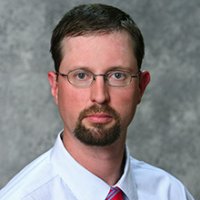
Title
Mesonet Operations ManagerOffice Building
Off-CampusMailing Address
Aberdeen Regional Center13 2nd Ave SE
Aberdeen, SD 57401
Biography
Edward's goal is to bring world-class monitoring of weather and water to his native South Dakota. Whether in agriculture, emergency management, water management or just a citizen checking the weather, there isn't a South Dakotan whose life isn't touched by weather everyday. Once Mesonet data is collected and archived, it is put to work again by researchers at SDSU and beyond to find solutions to benefit residents and industries of the state.Social Media Links
Education
- B.S. in physics | University of Nevada Reno | 2005
Committees and Professional Memberships
Committees
- Upper Missouri River Basin Monitoring Network, United States Army Corps of Engineers
- Governance/Siting Committee
- Instrumentation Committee (lead)
- Data Management Committee
- Executive Committee, National Coordinated Soil Moisture Monitoring Network (NCSMMN)
- Functional Standards and Practices Subcommittee, American Association of State Climatologists
- Mesonet Committee, American Association of State Climatologists
Professional Memberships
- American Association of State Climatologists
- American Meteorological Society
Extension Responsibilities
The Mesonet website, which receives more than a million page views annually, is one of SDSU's most visible and impactful outreach efforts. The Mesonet is also engaged with partners across the state such as the agricultural industry and Tribes to help them make use of the services the Mesonet provides.
Work Experience
In situ stations instrumented for earth science data collection have been the focus of most of Edwards' 20 year career. His introduction was at the Desert Research Institute supporting a research project to ground-truth satellite estimates of forest transpiration. He later served as a technician at the University of Nevada Reno, working on the state's 180 seismic monitoring stations with real-time telemetry for research and public safety. When first coming to SDSU, he did similar work on the state's network of hydrometeorological stations - now known as the South Dakota Mesonet - for research, public safety and agriculture.
Edwards soon came to lead the Mesonet, focusing on improved data quality, and uptime. This was accompanied by planning and fundraising that brought financial sustainability to the Mesonet.
Collaboration with tribes has been a focus for Edwards in his time with the Mesonet. The installation of new Mesonet stations have been an important part of addressing "data deserts" often found in Indian Country. A close working relationship with the Great Plains Tribal Water Alliance is another key component. All Mesonet stations' websites are now available in the Lakota language - both text and speech.
Edwards worked with state legislators, South Dakota Soybean, South Dakota Department of Agriculture and producers to explain weather's impact on pesticide application - especially the impacts of temperature inversions - and to get feedback on how the Mesonet could assist. As a result, the Mesonet deployed additional sensors at its stations and launched the Mesonet Spray Tool on its website to aid in decision-making.
Edwards has also been engaged in his field at a national level, serving on various committees and boards, participating in the the drafting of standards and strategy documents, and serving as a peer reviewer.
The last several years Edwards has largely dedicated to the expansion of mesonet coverage in the Upper Missouri River Basin. Edwards worked with Sens. Rounds and Thune who authored and funded the section of the Water Resources Development Act of 2020 calling for the creation of a network of 540 mesonet stations installed and operated by five state mesonets across the 270,000 square miles of the Basin's plains. This network will be the largest of its kind and is setting the standard for "total water" monitoring (snowpack, precipitation, evapotranspiration and soil moisture). It will provide more data types from more locations at higher quality than has been available for snowpack modeling, river forecasting and drought monitoring. Edwards has worked extensively on this project with the U.S. Army Corps of Engineers, the National Oceanic and Atmospheric Administration, the Natural Resources Conservation Service, numerous other federal agencies, mesonets of neighboring states, landowners and more. When the project is complete in 2027, not a snowflake or a raindrop will fall more than 20 miles from a station.
Areas of Research
- Agriculture pesticide application
- Soil climate
- Crop yield estimation
- Fire weather
- Public safety (severe weather, heat stress)
- Drought monitoring
- Hydrology (evapotranspiration, soil moisture, precipitation, snowpack)
Publications
- Fiebrich, C. A., Brinson, K. R., Mahmood, R., Foster, S. A., Schargorodski, M., Edwards, N. L., Redmond, C. A., Atkins, J. R., Andresen, J. A. and Lin, X. (2020). Toward the Standardization of Mesoscale Meteorological Networks, Journal of Atmospheric and Oceanic Technology, 37(11), 2033-2049. Retrieved June 10, 2021
- “A Strategy for a National Coordinated Soil Moisture Monitoring Network” contributing author
- American Association of State Climatologists “Recommendations and Best Practices for Mesonets” contributing author
- Cosh, M. H., Caldwell, T. G., Baker, C.B., Bolten, J.D., Edwards, N., Goble, P., Hofman, H., Ochsner, T.E., Quiring, S., Schalk, C., Skumanich, M., Svoboda, M., Woloszyn, M.E. Developing a strategy for the National Coordinated Soil Moisture Monitoring Network. Vadose Zone J. 2021;1−13. DOI:10.1002/vzj2.20139
- Baker, C. B., Cosh, M., Bolten, J., Brusberg, M., Caldwell, T., Connelly, S., Dobreva, I., Edwards, N., Goble, P., Ochsner, T. E., Quiring, S. M., Robotham, M., Skumanich, M., Svaboda, M., White, W. A., Woloszyn, M., 2022: Working toward a National Coordinated Soil Moisture Monitoring Network: Vision, Progress, and Future Directions. Bulletin of the American Meteorological Society, 103, E2719–E2732, DOI:10.1175/BAMS-D-21-0178.1.
Department(s)
Image for Department of Agricultural and Biosystems Engineering
Department of Agricultural and Biosystems Engineering
Image for Mesonet at SDState
Mesonet at SDState

